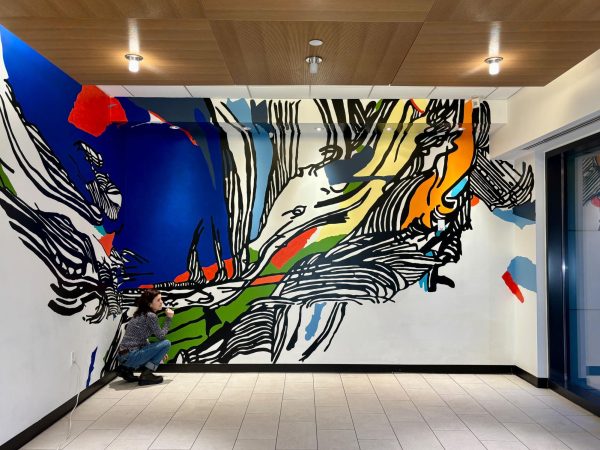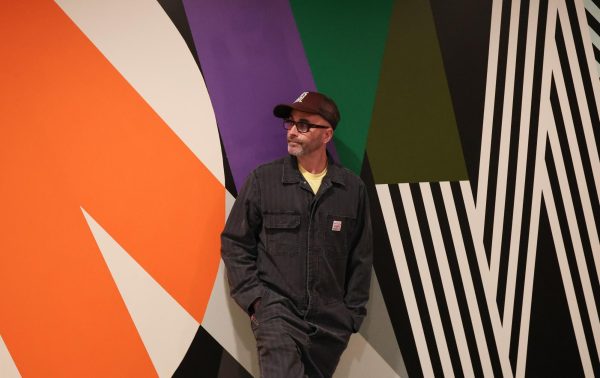For many upperclassmen at Emerson, their first impression of The Max a couple of years ago was clinical, blank walls, and standard gray dining tables. Since last spring, however, students entering the Piano Row dining area are now greeted with swaths of deep navy, soft orange, and bright green that dance around each corner of the space.
While students may have grown accustomed to the abstract flows of color tracing the walls of The Max over the past year, to the artist of this mural, Sophia Ainslie, it‚Äôs something more. Ainslie‚Äôs deeper meaning in the mural lies in the colorful shapes, which first took form over 15 years ago. The shapes were traced and evolved from X-ray imaging of Ainslie‚Äôs mother‚Äôs abdomen, where illness had taken root. Amidst the difficulties of caring for a sick parent, Ainslie found inspiration.¬Ý
“It looked to me like the universe. It was as big as all of that out there in the universe, and yet it was in her tiny body,” Ainslie said. “I suddenly understood that … the universe is reflected in us, and we are reflected in it.”
Ainslie, originally from South Africa, took these reflections she observed and made something with them. Following her mother‚Äôs death, she came back to Boston and developed a series of artworks over the course of multiple years inspired by the medical images. The last piece of this series now envelopes the walls of The Max.¬Ý
Ainslie‚Äôs mural, ‚ÄúLast Touch-Piano Row,‚Äù is just one of four that have popped up across Emerson‚Äôs campus this past year. The planning of the murals began in spring 2024, with the most recent one being finished this past spring. The four current murals are sponsored by the Fund for Public Art, a donation from Susan and Robert Morse, parents of a current Emerson student, according to Leonie Bradbury, Distinguished Curator-in-Residence and organizer of the mural project.¬Ý
“They saw the potential of the locations, and they just really wanted to contribute to making the campus more vibrant, and more representative of the creativity and artistic expressions that are happening at Emerson,” said Bradbury.
The murals in the Fitness Center, the Piano Row lobby, the Paramount Center, and The Max, completed by Ainslie and two other artists, all connect to an overarching theme: “FLOW.” Bradbury described how the theme allowed for a certain level of abstraction, as flow could describe energy or inspiration, for example.
‚ÄúI wanted to have a theme that was quite broad, but was also specific,‚Äù said Bradbury, ‚ÄúThere‚Äôs a lot of different ways you can think about flow.‚Äù¬Ý
Ainslie considered the flow of students in and out of The Max when planning her mural, but also how the different elements within the piece flowed.

‚ÄúThe colored shapes are about [my mother], the black line work is about me, and the white space is about absence,‚Äù said Ainslie.¬Ý
“I’m interested in trying to make the white negative space positive so that it has a sense of place,” she added. “What is absent doesn’t mean it’s not there … Even though [my mother] is not there, I still feel her.”
After years of focusing on this subject matter related to her mother, Ainslie said she wants “Last Touch-Piano Row” to represent her new artistic era.
‚ÄúThe Last Touch series is really my last touch of her because I felt like I’m trying to move away from this content,‚Äù she said. ‚ÄúIt‚Äôs more about a celebration of her life than a mourning.‚Äù
This celebration of life extends to the broader mission of the murals to bring joy into spaces on campus, according to Bradbury.
“When you don’t [have art], it’s kind of soul-deadening to be in these very generic spaces where you can’t even identify if you are in a hospital or an office building,” she said. “If you have art on the walls … it shows a commitment to the value of aesthetics, to the value of art being in our society, to being surrounded by beautiful things.”
Each of the artists selected by Bradbury is based in the Boston area, a choice that ties to the mission of expanding artistic outreach. Bradbury said that the resources from the donors allowed Emerson to invest in the local arts community while enriching the campus atmosphere.
“They saw the potential of the locations, and they just really wanted to contribute to making the campus more vibrant, and more representative of the creativity and artistic expressions that are happening at Emerson,” said Bradbury.
When walking through the lobby of Piano Row, students are met with Cyrille Conan’s mural titled “Tremen,” which translates from Breton, a language native to Brittany, France, to “passage.” Conan, whose family hails from this region, also borrowed from the language for “Mohrent,” or maritime, located one flight down from the lobby on the interior wall of the Fitness Center. “Mohrent” was the first of the four current murals to be completed upon the opening of the center last fall.

Conan, a French-American artist who specializes in painting geometric shapes, was brought onto the project to incorporate the flow of the exposed architectural elements in the Fitness Center into the mural.¬Ý
“I do really like to incorporate the architectural elements into the work,” Conan said. “There’s a lot of visual elements in the murals that kind of speak to each other, like the line work and the spheres and all these natural geometric forms. I basically just play with all of this stuff. That’s how it all came together.”
The black lines in both of Conan’s murals were inspired by a World War I British Navy camouflage strategy called dazzle camouflage. As these lines blend into the ceilings of the Fitness Center and seem to transform its shape, Conan brought in more maritime inspiration with the colors he used, saying they were partly inspired by a trip he took to Cape Cod and Boston’s maritime history.
“This is Boston, it’s one of the oldest active fishing ports in our country. I kind of wanted to celebrate that, so I took that as a direction,” Conan said.
Conan said his own identity flowed into the murals as he titled them.¬Ý
“I always hated titling things. Over the years, I just ended up in this direction … This is part of my identity, of my history. Why not celebrate it?”
The Paramount Center houses the fourth mural on its fifth floor designed by Dominican artist Silvia López Chavez, who composed it of spray paint along with stenciled patterns.
All of the murals sponsored by the Fund for Public Art aim to “ensure that Emerson students will continue to learn, engage, and be inspired by bold works of art for years to come,” according to a press release announcing the works.
“It’s not just my goal. I know it’s the goal of the larger administration and community at Emerson that we all know we need art,” said Bradbury. “We need more art by all different people and our students, and our faculty.”
There is one more mural planned as part of the Fund for Public Art that Bradbury hopes will be executed next semester, but the artist and location are not set at this time.
“There’s been a lot of different challenges on our campus recently in terms of our community and feeling connected to one another,” Bradbury said. “With this series of artworks, we wanted to contribute to some positive energies and positive vibes on our campus that could maybe help people feel like they could belong in a different way.”